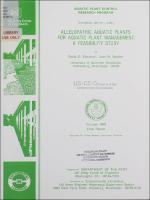Please use this identifier to cite or link to this item:
https://hdl.handle.net/11681/6323Full metadata record
| DC Field | Value | Language |
|---|---|---|
| dc.contributor.author | Elakovich, Stella D. | en_US |
| dc.contributor.author | Wooten, Jean W. | en_US |
| dc.creator | University of Southern Mississippi | en_US |
| dc.creator | Aquatic Plant Control Research Program (U.S.) | en_US |
| dc.creator | Environmental Laboratory (U.S.) | en_US |
| dc.date.accessioned | 2016-03-23T19:54:35Z | en_US |
| dc.date.available | 2016-03-23T19:54:35Z | en_US |
| dc.date.issued | 1989-10 | en_US |
| dc.identifier.govdoc | Technical Report A-89-2 | en_US |
| dc.identifier.uri | http://hdl.handle.net/11681/6323 | en_US |
| dc.description | Technical Report | en_US |
| dc.description.abstract | This report presents results of a literature search and feasibility study of the use of allelopathic aquatic plants for aquatic plant management. To establish a list of potential allelopathic plants, 16 aquatic macrophytes native to the southeastern United States were subjected to two bioassays -- one involving lettuce seedlings and one involving the aquatic plant Lemna minor as the target species. The results suggest that Nymphaea odorata and Brasenia schreberi are both highly inhibitory and are therefore candidates for aquatic weed management. The results also indicate that the simple lettuce seedling assay may be a reasonable first "easy" assay for determining the allelopathic potential of aquatic plants. | en_US |
| dc.description.sponsorship | Aquatic Plant Control Research Program (U.S.) | en_US |
| dc.description.sponsorship | United States. Army. Corps of Engineers | en_US |
| dc.description.tableofcontents | Preface................................1 Introduction................................3 Background................................3 Interactions among plants................................3 Literature Review................................6 Bioassay Procedures................................7 Selection of study plants................................7 Plant collection and procedding................................8 Lettuc seedling bioassay................................9 Lemna minor bioassay................................10 Comparison of lettuce seedling and Lemna minor bioassay results................................16 Conclusions and Recommendations................................18 References................................20 Tables 1-5 Appendix A: Annotated Bibliography of Aquatic Plant Allelopathy................................A1 | en_US |
| dc.format.extent | 38 pages/7.47 MB | en_US |
| dc.format.medium | en_US | |
| dc.language.iso | en_US | en_US |
| dc.publisher | U.S. Army Engineer Waterways Experiment Station | en_US |
| dc.relation | http://acwc.sdp.sirsi.net/client/en_US/search/asset/1043651 | en_US |
| dc.relation.ispartofseries | Technical Report (Aquatic Plant Control Research Program (U.S.)) ; no.Technical Report A-89-2 | en_US |
| dc.rights | Approved for public release; distribution is unlimited | en_US |
| dc.source | This Digital Resource was created from scans of the Print Resource | en_US |
| dc.subject | Allelopathy | en_US |
| dc.subject | Bioassay | en_US |
| dc.subject | Growth inhibition | en_US |
| dc.subject | Aquatic macrophytes | en_US |
| dc.subject | Aquatic plants | en_US |
| dc.subject | Biocontrol | en_US |
| dc.subject | Biological control | en_US |
| dc.subject | Lemna minor | en_US |
| dc.subject | Aquatic Plant Control Research Program (U.S.) | en_US |
| dc.title | Allelopathic aquatic plants for aquatic plant management : a feasibility study | en_US |
| dc.type | Report | en_US |
| Appears in Collections: | Technical Report | |
Files in This Item:
| File | Description | Size | Format | |
|---|---|---|---|---|
| TR-A-89-2.pdf | Technical Report A-89-2 | 7.47 MB | Adobe PDF |  View/Open |